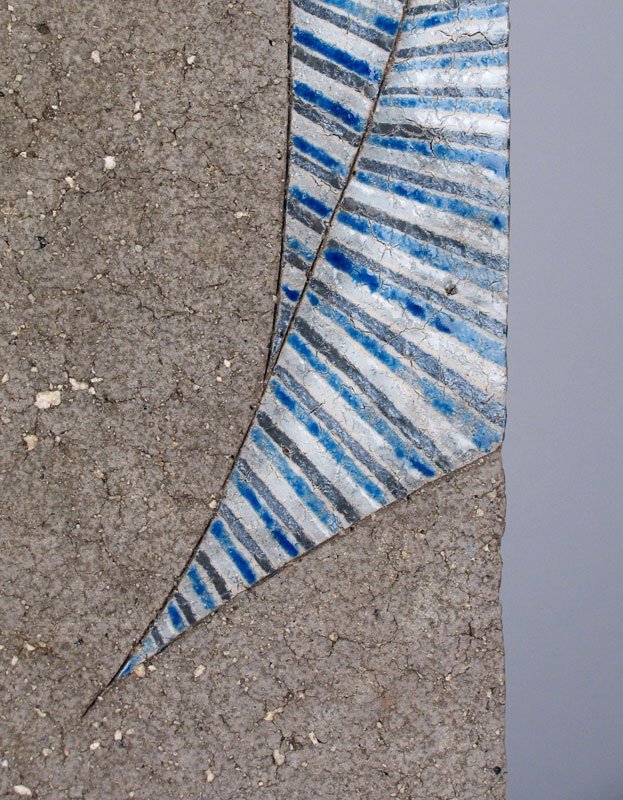POST WAR & CONTEMPORARY
KAMADA SHOJI, 1977, ENAMELED STONEWARE, PRISM VASE
Vase in the form of a tall, rectangular prism. Of grey stoneware ornamented with flowing, abstract designs composed of blue, white and grey stripes of enameled porcelain, that sail around the corners. Signed and dated on the reverse with an incised signature by the artist: Sen Kyu-hyaku Nana-ju Nana, Sho or 1977, Sho (Kamoda Shoji, 1933 – 1983). Showa 52 or 1977.
With the tomobako or original box, inscribed on the interior of the lid: Sen Kyu-hyaku Nana-ju Nana, Tsubo or 1977, Jar, and signed: Kamoda Shoji, and sealed.
Born in Kishiwada City near Osaka, Kamoda Shoji studied ceramics under Tomimoto Kenkichi at the Kyoto Municipal College of Art (presently known as Kyoto City University of Arts). Along with Morino Taimei (who graduated two years after Shoji), he is considered “one of the joint heirs” to Tomimoto’s mantle. After graduating in 1956, he worked at a pottery studio related to the Hitachi Factory in Hitachi City, Ibaraki Prefecture. In 1959, he became an independent artist, borrowing a kiln at Mashiko in Tochigi Prefecture. In 1961, along with his wife Masako, Kamoda was accepted for the first time into the Japan Traditional Crafts Exhibition with a work of iron glaze. He was awarded the 10th Takamura Kotaro Prize in 1967, the only potter to receive this prize. His work from this period (1961 – 1966) moved from a style inspired by early Japanese stonewares of the Nara and Heian periods towards his adoption of polychrome decoration. The decision to abandon his earlier style led to his withdrawal from the Japan Crafts Association in 1968. By 1970 he had moved his workshop from the ceramics center of Mashiko to the remote northeastern town of Tono in Iwate Prefecture. Tono’s clay, used in the manufacture of roof-tiles, was for Kamoda a major discovery. As Rupert Faulkner of the Victoria and Albert Museum writes in Japanese Studio Crafts (page 54), this clay was “highly plastic, rich in iron and full of particles of silica…[and] Kamoda was to use this clay in its unrefined state for the rest of his career. Its roughness was a key factor in his decision to change from wheel-throwing to hand-building.” His work from this Tono period focused on curvilinear carving and polychrome ornamentation. At the age of 40 in 1974, he received the Award for New Artist of the Education Minister Award for Art. By this time, his reputation was soaring and his work was avidly sought by collectors. Kamoda Shoji died of leukemia in 1983, just before the age of fifty, cutting short the brilliant career of one of the 20th century’s greatest potters.
Kamoda built this vase with a slab construction of coarse, unrefined, grey clay. Inclusions of small, white stone break the surface. The edges he carved in sharp, clean lines that curve inwards towards the square mouth. A crisply inset band at the foot complements the form. Contrasting with the rough, unglazed surface of the clay and the massive form, the gleaming, enamel ornamentation sails lightly around the corners, lending the vase a sense of whimsy and almost musical movement.
For a similar vase also dated to 1977, c.f. the catalogue Kamoda Shoji – A Retrospective, number 139.
Kamoda Shoji, 1977, Enameled Stoneware, Prism Vase
Artist Name: Kamada Shoji
Period: Showa Post War
Mediums: Ceramic, Porcelain
Form: Vase
Origin Country: Japan
16 1/8” high x 5 7/8” x 5 7/8”
This piece is no longer available.






